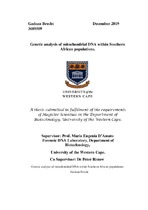Genetic analysis of mitochondrial DNA within Southern African populations.
Abstract
As human beings we are curious about our origin and ancestry. A curiosity has led to an investigation of human evolution and expansion across the world by means of population genetics and phylo-genetics by evaluating a region in Southern Africa that is largely unknown.
The objective of this study was to develop a quick, inexpensive and accurate hierarchical diagnostic screening system of the MtDNA phylogenetic tree, AI-SNPs in the mtDNA genome by using High Resolution Melting analysis to evaluate the population composition and ancestral haplogroups of Southern African populations in Limpopo. The admixture between the ‘Khoesan’ hunter-gatherers, herders and the Bantu speaking populations led to population growth and expansion in Limpopo. This has contributed to populations settling in Limpopo and has thus shaped the ancestral contemporary populations. No research on these individuals residing in Limpopo has been done before, thus an investigation of their ancestral origin was necessary. A total of 760 saliva samples were collected from individuals residing in Limpopo. Only 500 saliva samples were extracted by means of an optimized salting out technique. Five hundred extracted genomic samples were genotyped by means of a quick, inexpensive High-resolution melting analysis. Of the 500 samples, the genotyping results showed 95 individuals derived for the L3 haplogroup which gives a 19% ratio of individuals screened with Multiplex 1. Only 56 individuals were derived for the L1 haplogroup, which gives a percentage of 11%. A total of 249 individuals were derived for the L0 haplogroup, making up a 50% of the total individuals genotyped. Only 100 samples were derived for L0a, making up 20% of individuals screened with Multiplex 1. Of the 95 samples derived for the L3 haplogroup, the results showed 87 individuals to be ancestral for both M and N, making up 91.57% of individuals screened with Multiplex 2. http://etd.uwc.ac.za/. In population genetics using SNPs to infer population history and ancestral origin has become significant, this study allowed researchers to evaluate population groups by investigating their genetic markers and the application of the results allowed for downstream analyses. Finally, this study provides a quick and simple screening method for the selection of lineages that are of interest for further studies.

